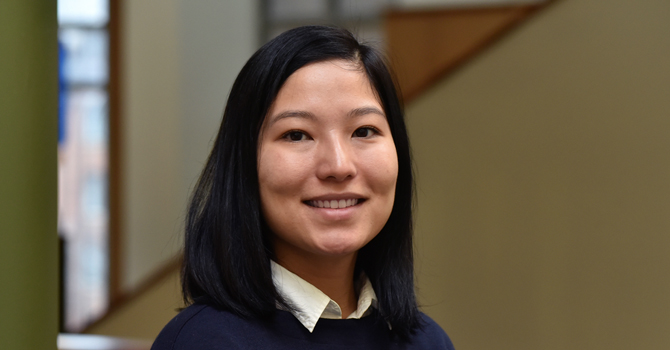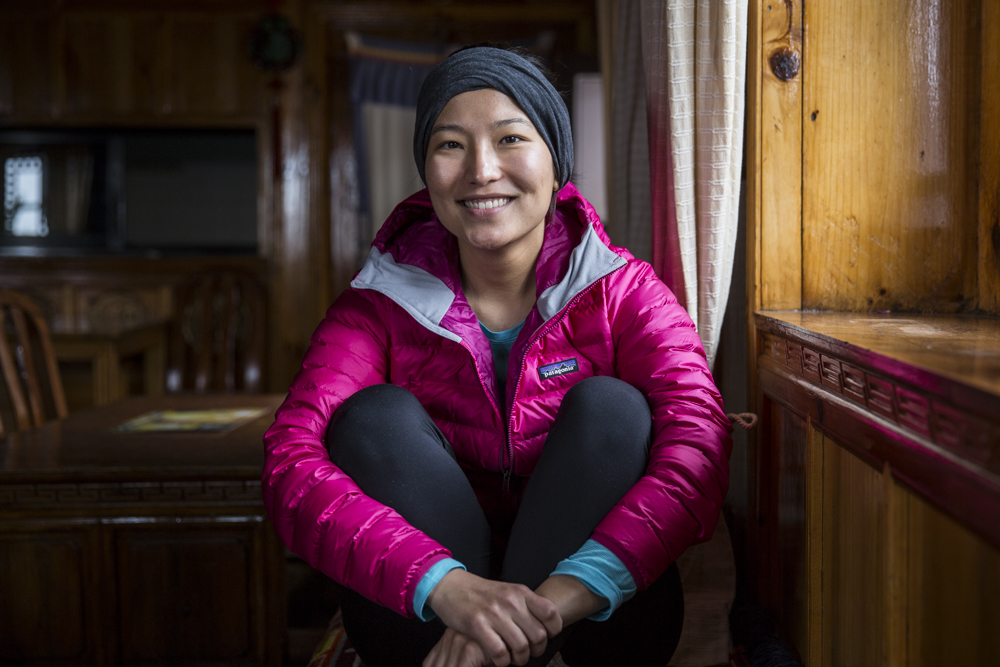Drilling for DNA: The Unexpected Adventures of a Public Health Anthropologist

Ainash Childebayeva, PhD ’19
Department of Archaeogenetics, Max Planck Institute for the Study of Human History
When people hear the word anthropology, they might think of skeletal remains, ancient writing systems, or endangered languages. Rarely do they imagine a person sitting in a lab wearing goggles and a lab coat. But depending on the branch of anthropology—cultural, linguistic, archeological, and biological are the four traditional subfields—anthropology can be a pretty lab-based science, especially if you’re in biological anthropology.
I grew up in Almaty, Kazakhstan, and as a child often got to visit my grandmother at work. She was a medical doctor and directed a phlebotomy lab where they did a lot of blood analysis. She would answer the many questions I had while exploring the lab, thus cultivating my interest in clinical research and public health. I would soon realize I could pursue both.
As an undergrad at Vanderbilt University, I studied and worked in the lab of Dr. Amy Non, a genetic anthropologist (now at the University of California, San Diego) who looks at the effects of stress on the epigenome—the chemical “software” that sits on top of and directs the expression of our genetic “hardware.” I worked closely with Dr. Non on the Bucharest Early Intervention Project, a study evaluating the effects of early developmental stress on Romanian children growing up either in foster care or in institutional settings.
Seeing the profound influence of environmental stress on genetic expression and overall human health brought me to the long, rewarding path of becoming a public-health researcher.
Seeing the profound influence of environmental stress on genetic expression and overall human health brought me to the long, rewarding path—a joint PhD at the University of Michigan—of becoming a public-health researcher of ancient human genetics. A joint doctorate is relatively unusual due to the workload and need to coordinate between departments, and I credit the good people of Michigan’s department of Biological Anthropology and the School of Public Health’s department of Environmental Health Sciences with trusting me to pursue and complete a dual degree like this. Everyone collaborated together in helpful ways to make my path manageable and enjoyable.
Adventures of an Anthropologist
In addition to fulfilling my intellectual interests, anthropology can be quite an adventurous field. I mentioned labs and goggles, but we also look at skeletal remains to study ancient DNA to understand topics from human migrations to human epidemiology of the past. Finding those ancient samples can be challenging. Most DNA samples are taken from living people (with consent, of course). Ancient DNA is taken from the remains of long-dead organisms, including humans. We can extract DNA from the bones or teeth of someone who died a long time ago, sometimes up to 700,000 years ago.
You can also collect DNA from the dense bone on the inner ear, but you have to drill out bone powder to get the DNA sample. You have to work with what you have.

The Neanderthal genome was actually extracted from teeth. You’re looking for DNA mostly in the root area where there are a lot of nerves and blood vessels. If you have good preservation, like with permafrost of Siberia, you can get good DNA from teeth—sometimes even from a pinkie bone, as in the case of the Denisova genome. You can also collect DNA from the dense bone on the inner ear, but you have to drill out bone powder to get the DNA sample. You have to work with what you have.
More about Ainash
Her team’s Everest Base Camp work was published recently in the journal Frontiers in Genetics.
When she goes to Peru, she flies in and almost immediately travels from Lima up to the research station, which is 14,000 feet up. One day is not quite long enough to climatize, and she usually gets acute mountain sickness.
Our location in Peru was likely the site of a massacre—everyone there had been killed, dismembered, and defleshed. It is unclear why these individuals were massacred in this way. It was likely violence toward another group, but this particular civilization did not leave any written records, so we are speculating to some degree. We do have enough evidence, however, to proceed with our genetic inquiries.
To study anthropology, I’ve developed a lot of technical skills well beyond the lab. And some of the field work begins to sound like a scene from an adventure movie.
Atop Mountains and Inside Cells
I knew coming to Michigan that I wanted to study public health and wanted to work with Dr. Dana Dolinoy, because her work is closely related to the broad health questions I address in my own research.
My primary research interest—how environmental exposures impact humans—took me to high-altitude work in Peru, looking at how low oxygen levels stress the human body. The interest in lead exposure came about serendipitously. Our high-altitude population in Peru is located in a mining town. We collected samples, went back to the lab, and noticed a lot of lead exposure. I knew we needed to look at that as well, because lead exposure affects the epigenome. So we returned to Peru and ran additional tests to make sure we had the full picture.
Looking at toxicity is where my public health training in epigenetics is opening up new possibilities for me as an anthropologist.
Looking at toxicity—how chemical exposures affect what’s happening inside human cells—is where my public health training in epigenetics is opening up new possibilities for me as an anthropologist. I was looking for high altitude stuff and ran into lead. Lead complicated things, but I had to look at it—because humans are so complicated. We don’t live in sterile environments where we’re exposed only to one thing at a time. We have to look at multiple exposures at the same time because that’s our reality and that’s how we can get real solutions to our exposures.
Public health is good at piecing together multiple factors, especially when they’re embodied in a single person or a single population. In working at the intersection of anthropology and public health, I have realized it is up to the researcher to establish potential interactions and draw meaningful connections. Any two fields can interact—it takes a human researcher to be interested enough in those topics to bring them together. I’m interested in how humans live and how they evolved. The exposures I research are part of that story of evolution.
For any researcher, it is important to be able to think in different ways, to get different points of view, and to learn different analytical techniques.
I benefit immensely from being in the public health environment, where we take different approaches to questions than in an anthropology context. For any researcher, it is important to be able to think in different ways, to get different points of view, and to learn different analytical techniques.
My research questions mean I need both public health and anthropology to answer them. Dr. Dolinoy and Dr. Abigail Bigham were remarkably supportive and very open to this joint doctorate endeavor. I found in general that faculty at Michigan are open to collaborating and to having students creating interdisciplinary projects, which so often are necessary to answer real, human questions.
All of that has to do with public health because today people are still exposed to all kinds of harmful things. Public health changed my anthropological work in ways I hope will impact human knowledge and improve public policy so that people can lead healthier lives. Perhaps we can relocate people in Peruvian mining towns or provide additional health services for children exposed to lead. Across many disciplines and many borders, I know we can help people.
- Interested in public health? Learn more here.
- Read more stories about Environmental Health Sciences students, alumni, faculty, and staff.
- Support research and engaged learning at the School of Public Health.
